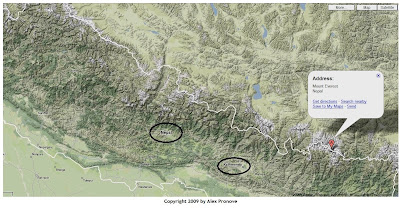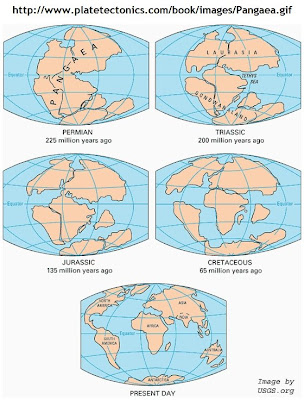 WHAT FORCES CREATED THE HIMALAYAN MOUNTAIN RANGE?
WHAT FORCES CREATED THE HIMALAYAN MOUNTAIN RANGE?Everest, the tallest mountain in the world, towers nearly nearly nine kilometers. Everest is the most famous peak of the Himalayan mountain range. And that range, in turn, is one of the most celebrated features of our planet. What forces created it?
(You can enlarge any image by clicking on it. To return to this page, click on the back-arrow of your browser or press the Backspace key on your keyboard.)
An earlier post noted that four of the most accomplished climbers in the world began ascending Mt. Everest. What forces created Everest and the mountains around it?
The Collision of India and Asia
India did, or more precisely, the tectonic plate that India sits on, did. India’s plate has been pushing against the Asian landmass for the past 50 to 55 million years. The collision of two landmasses caused the earth to buckle up at these points of collision. The earth, at these points of collision, is literally being pushed up to form mountains.
(You can enlarge any image by clicking on it. To return to this page, click on the back-arrow of your browser or press the Backspace key on your keyboard.)




Plate Tectonics
Early in the 20th century, a scientist named Wegener proposed that continents “drift.” Any world map will show the bulge on the eastern side of South America and the “hole” on the western side of Africa. The bulge appears to fit into the hole, doesn’t it? It appears that the two continents may have been one in the distant past. It appears, therefore, that South America and Africa separated. This observation among other, prompted Mr. Wegener to propose that continents drift. Later on, geologists confirmed that the uppermost layer of our planet moves around. Imagine the land that we see actually sits on a plate and that plate, in turn, rests on thick mud. The plate moves—albeit very slowly—and the land sitting on it naturally moves as well.
 It’s such a radical notion, isn’t it? Land, after all, is the ground. Expressions such as “feet on the ground” or “grounded in reality” suggest a pragmatic let’s-be-real attitude. It also explains why earthquakes terrify us. After all, if the very ground that we believe is solid shakes, then what is solid?
It’s such a radical notion, isn’t it? Land, after all, is the ground. Expressions such as “feet on the ground” or “grounded in reality” suggest a pragmatic let’s-be-real attitude. It also explains why earthquakes terrify us. After all, if the very ground that we believe is solid shakes, then what is solid?Science believes that in the distant past, there existed only one landmass (that was named Pangaea). Over time—as in 225 million years—this single landmass separated into the seven continents we know today.
 India sits on its own plate and that plate is currently moving northeast at five centimeters per year (that’s two inches per year). According to the Paleomap Project, before India collided with Asia, India was moving at more than 15 centimeters per year. No modern plate moves that fast. (India’s northward race towards Asia may be something of a plate tectonic speed record!)
India sits on its own plate and that plate is currently moving northeast at five centimeters per year (that’s two inches per year). According to the Paleomap Project, before India collided with Asia, India was moving at more than 15 centimeters per year. No modern plate moves that fast. (India’s northward race towards Asia may be something of a plate tectonic speed record!)The Himalayas, therefore, were created by the collision of India with the rest of Asia. Tectonic forces, in other words, created the Himalayas.
Two things about this knowledge amaze me. First, these mountains originally constituted the seafloor. What was once, perhaps, eight kilometers below sea level are now eight kilometers above it. And second, these mountains—already the concentration of the tallest in the world—will continue to rise even more over the next millions of years.
Isn’t that something?

No comments:
Post a Comment